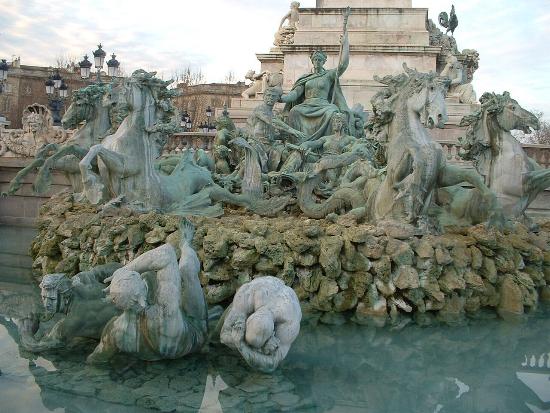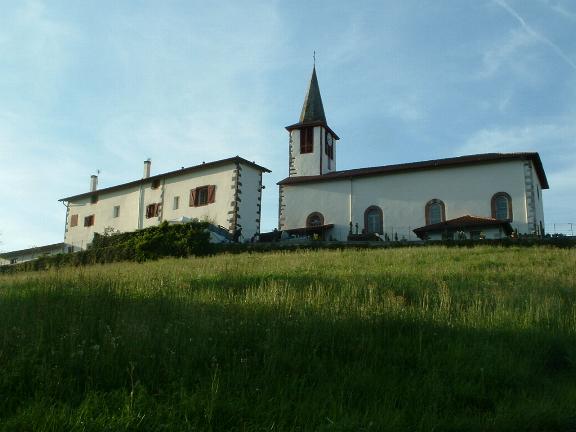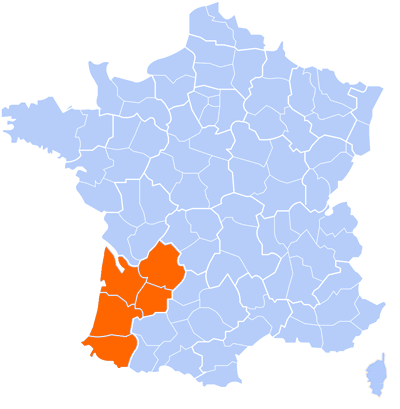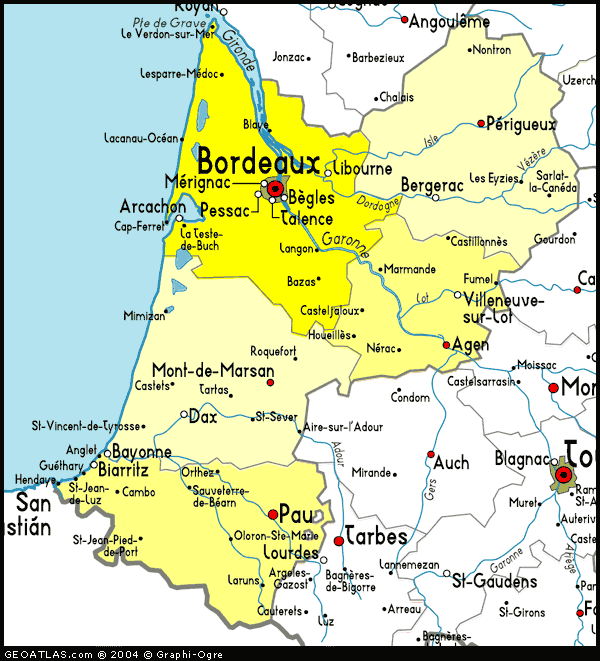|
 |
 |
 |
 |
 |
 |


Aquitaine covers an area of 41,308 km², 7.6 per cent of France's total area. It is bounded to the south by Spain, to the east by Midi-Pyrénées, to the north by Poitou-Charentes and Limousin and to the west by the Atlantic Ocean .
Major cities in Aquitaine include Bordeaux, Pau, Bayonne, Mont-de-Marsan, Biarritz, Bergerac, and Périgueux.
Major geographical features include:
- The Côte d'Argent, one of the most famous coasts in France.
- The Bassin d'Arcachon, a large lagoon famous for its oyster farming.
- The confluence of the Garonne and the Dordogne rivers which leads to the vast Gironde estuary.
- The south of the region includes parts of the Pyrenees mountains.
- The Dune de Pilat, near Arcachon is the largest sand dune in Europe.
(source: wikipedia)

UNESCO heritage sites in Aquitaine
Location of Aquitaine


History of Aquitaine
In Roman times, the province of Gallia Aquitania originally comprised the region of Gaul between the Pyrenees Mountains and the Garonne River, but Augustus Caesar added to it the land between the Garonne and the Loire River. At this stage the province extended inland as far as the Cevennes and covered an area about one third of the size of modern France. Aquitaine was quite thoroughly Romanized in its culture, unlike northern Gaul.
The 4th century AD saw the Roman province of Aquitaine divided into three separate provinces:
- Aquitania prima, the north-eastern portion, including the territories which later became Berry, Bourbonnais, Auvergne, Velay, Gévaudan, Rouergue, Albigeois, Quercy and Marche
- Aquitania secunda, the northwestern portion, with its capital at Burdigala (Bordeaux) and comprising the future Bordelais, Poitou, Saintonge, Angoumois and western Guyenne
- Aquitania tertia or Aquitania Novempopulana (of the "nine peoples"), the southernmost and most strongly Basque portion, adjoining the Pyrenees and covering what later became Bigorre, Comminges, Armagnac, Béarn, the Basque country, Gascony, etc.
In the 5th century, as Roman rule collapsed, the Visigoths filled the power vacuum, until they were driven out in 507 AD by the Franks, with a mixed army of mercenaries and federates, who included Burgundians. When Clotaire II died in 629, he divided the kingdom of the Franks and gave Aquitaine to his son Charibert II, who set up his capital at Toulouse and strengthened his claims by marrying Gisela, the heiress of Aquitania Novempopulana. However, Frankish control was never very secure; they were primitive by comparison and had only the most rudimentary sense of urban life and the res publica. Aquitaine put up little resistance to the Moors in the 8th century, but Charles Martel drove them out, and Aquitaine passed into the Carolingian Empire.
The heirs of Charlemagne divided and redivided their inheritance, and Aquitaine passed out of the control of Neustria, the western kingdom of Charlemagne's house. Thus, in the 9th century the leading local counts gradually freed themselves of the vestiges of royal control. Bernard Plantevelue (ruling 868-86) and his son, William I (ruling 886-918), whose power base was in Auvergne, called themselves dukes of Aquitaine for a time. William V (ruling 995-1030) refounded a new duchy of Aquitaine based in Poitou, and this power center survived. Aquitaine contained Poitiers, Auvergne, and Toulouse. In 1052 the duchy of Gascony (French: Gascogne) became part of "Aquitania", by personal union of duke William VIII. Aquitaine achieved a high literate court culture of courteoisie that peaked under William VIII (ruled 1058-86). Duke William IX, "the troubadour" was a poet himself, and Poitiers became a center of the musical poetry of the troubadours. When William X died (1137), his daughter Eleanor of Aquitaine, the greatest heiress of France, married her feudal overlord Louis VII of France and followed him on crusade, then had the marriage annulled under the pretext of consanguinity in 1152 to marry his greatest rival Henry II of England. She maintained an elegant chivalric court at Poitiers. Her sons, Richard I and John, and their successors as kings of England were dukes of Aquitaine (later known as Guienne).
Fighting during the Hundred Years' War enabled Edward III of England to establish the principality of Aquitaine in 1361, freed from any dependence on France, but France recaptured it by 1453. After that the history of Aquitaine became part of the history of France.
(source: wikipedia)






